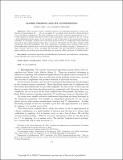Matrix Probing and its Conditioning
Author(s)
Chiu, Jiawei; Demanet, Laurent
DownloadChiu-2012-MATRIX PROBING AND I.pdf (547.3Kb)
PUBLISHER_POLICY
Publisher Policy
Article is made available in accordance with the publisher's policy and may be subject to US copyright law. Please refer to the publisher's site for terms of use.
Terms of use
Metadata
Show full item recordAbstract
When a matrix A with n columns is known to be well-approximated by a linear combination
of basis matrices B1, . . . , Bp, we can apply A to a random vector and solve a linear system to recover this linear combination. The same technique can be used to obtain an approximation to A[superscript −1].
A basic question is whether this linear system is well-conditioned. This is important for two reasons:
a well-conditioned system means (1) we can invert it and (2) the error in the reconstruction can be controlled. In this paper, we show that if the Gram matrix of the Bj ’s is sufficiently well-conditioned and each Bj has a high numerical rank, then n [infinity symbol] p log[superscript 2] n will ensure that the linear system is well-conditioned with high probability. Our main application is probing linear operators with smooth pseudodifferential symbols such as the wave equation Hessian in seismic imaging [L. Demanet et al., Appl. Comput. Harmonic Anal., 32 (2012), pp. 155–168]. We also demonstrate numerically that matrix probing can produce good preconditioners for inverting elliptic operators in variable media.
Date issued
2012-02Department
Massachusetts Institute of Technology. Department of MathematicsJournal
SIAM Journal on Numerical Analysis
Publisher
Society for Industrial and Applied Mathematics
Citation
Chiu, Jiawei, and Laurent Demanet. “Matrix Probing and Its Conditioning.” SIAM Journal on Numerical Analysis 50.1 (2012): 171–193. Web.
Version: Final published version
ISSN
0036-1429